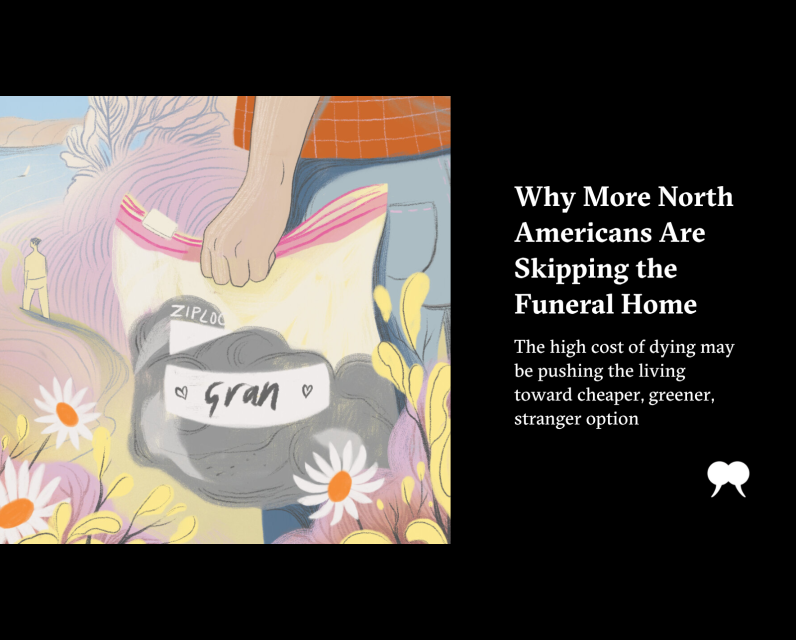Source Feed: Walrus
Author: Ellen Himelfarb
Publication Date: July 4, 2025 - 06:30
Why More North Americans Are Skipping the Funeral Home
July 4, 2025

My parents purchased their burial plots nearly forty years ago. My mother likes to pull out the story about what a great deal they got because the plots were a cemetery resale—the previous owners, then in the midst of a divorce, wanted to make their separation eternal. Years later, mom says, one of their descendants tried to reverse the deal and buy back the land. To which my father said, “Fuck him.”
I always laugh at this joke, not because it’s likely embellished (my dad rarely, if ever, cursed) but because who shops for graves in their prime? In rude health? Still in their starter home?
I thought about this after we buried my father last year, a buffer between those long-standing exes. My husband and I had been visiting from our home in the UK, where we live as expats. We share neither the same citizenship nor religious background. Our teenage children each hold three passports. By the time we retire, they could be anywhere. We could be anywhere. If that much is uncertain, browsing for burial plots is unlikely to make it onto the weekly planner.
Maybe our situation is atypical, but our ambivalence toward caskets, headstones, and other traditional Judeo-Christian death apparatus is not. People in the West don’t typically ponder death if we don’t believe it’s imminent—or we do, yet stop short of putting money down. Our spirituality has changed form drastically over the decades; churches are as likely to be condos as places of worship, and alternative religions with disparate attitudes toward death have been gaining popularity. Some fret about land scarcity. Others shirk at the cost: upward of $5,000 for a macabre ritual they don’t believe reflects their personal brand.
And yes, intermarriage—blending race, religion, nationality—is a growth area. It’s why Barbara Kemmis, executive director of the Cremation Association of North America, says there are fewer funerals in places with high immigration, like Florida, despite the relatively high death rate. “More diversity equals more options,” she says. “Immigrants may send their parents’ bodies back to the old country. And subsequent generations do what the people around them do.”
What the people around them are doing is cremating, largely. People used to believe that we don’t cremate those we love. Today, Canada cremates more than 75 percent of its dead, up from 58.9 percent in 2008, with British Columbia reporting the highest rate at 86.8 percent. In 1970, the cremation rate in the US and Canada was 5 percent.
It might not hurt that ovens, to be callous, cost about a quarter of coffins. While a death certificate must be issued before a cremation can proceed—and that can sometimes take weeks depending on the circumstances, which is longer than my Jewish family would abide—they’re usually easier to plan. Old urban cemeteries are closing to new applicants; meanwhile, a “direct cremation” can be triggered at any time (no visitation, no fanfare). These service-less services—cash for a Ziploc bag marked “remains”—are rare, Kemmis admits. Most find it no easier to swerve around the trappings of death than to outrun death itself. Even in middle age, though, I can’t get used to the idea of taking “ashes to ashes” so . . . literally.
Cremation antipathy is real. And for eco-warriors, it’s about more than dread. They’ve done the math: a single cremation emits as much carbon dioxide as driving just over 750 kilometres and uses enough fuel to heat your home for a month. Alternatives, however, are thin on the ground. A more sustainable “human composting” option called terramation—encasing the body in organic wood chips and alfalfa, whose microbes break down the body into soil—is still illegal in Canada. The Seattle company Return Home offers terramation to Canadians willing to cover the not-uncomplicated business of shipping, but in the meantime, there’s space for creativity. Aquamation, a low-emissions/low-consumption water cremation, is another alternative, like a postmortem Jacuzzi in a biodegradable body bag, except the temperature is high and a hydroxide chemical is added to the water to trigger decomposition.
“Personally, I’d like to be water cremated and have my ashes made into concrete to help rebuild coral reefs,” says Robyn Lacy, an archaeologist and death scholar living in St. John’s. Despite Lacy’s work in cemetery conservation, she doesn’t decry the waning currency of hallowed churchyards. “A shift away from ‘traditional’ inhumation will bring other ways of memorialization,” she says. “Making individualized gravestones was popularized in the seventeenth century, so I see changes to that practice more as an evolution of our continuously changing burial traditions.”
Indeed, people in the business of “natural burials,” a flourishing practice favouring willow boxes and linen shrouds over embalming and heavy caskets, consider themselves traditionalists. “This is the way most people were doing it until World War II,” says Susan Greer, executive director of the Natural Burial Association, which oversees several undeveloped woodland sites across Southern Ontario. Greer advocates for full-body burial, “because that’s when we’re taking the best possible option for our environment.” (She avoids the word “green,” perhaps lest its “woke” connotations turn off the natural-burial curious.)
Markers range from flat metal plates to willow sculptures to nothing at all, like at one site in Southern Ontario where sheep graze and the dead vanish into the earth. Descendants get access rights to the plot in perpetuity and, helpfully, the GPS coordinates that mark it.
“A lot of people are recognizing that death is an important milestone, but nothing they’re doing in practice is resonating with them,” says Greer. By giving back to the earth on a cellular level, she says, “your legacy is not an eight-by-three-foot area. It’s the entire natural arc.” Unsurprisingly, the process appeals to Buddhists, Muslims (they can lie facing Mecca), intermarried couples like myself, and likely many other mourners who feel less inhibited surrounded by trees and birdsong. “An unwritten tenet of natural burial is having people engage in the goodbye,” says Greer. “Once the cedar bough is laid out and they see the beautiful place Mom is going to be, they want to help decorate the plot.”
I suppose, as with any big purchase, options translate to customer control. It hadn’t occurred to me, until sitting down to write this, how my family’s entrenched traditions have limited my own perception of control. I think they’d turn over in their graves if I dispensed with the rabbi and had myself planted in a bamboo forest. Still, it’s nice to know the option is there.
What brought this home was speaking to Mel Bennett in New Hampshire, who co-founded Life Forest in 2019 after losing her mother to a lengthy illness. Shortly thereafter, she was handed a cardboard box of ashes. “I thought, ‘This is not good enough.’ I just wanted something for my mom, and I wanted a say in how it was done.”
Bennett considered planting a tree in place of a headstone, but no cemetery would allow it. So she did it herself on a tract of land. When she gradually learned that others yearned for more control over commemorating their loved ones, she opened the land for “living memorials,” becoming something of a trailblazer in new death care. Life Forest was the first in North America to sanction a tree as a legal memorial, to bury people legally with their pets, to link QR codes to burial plots. The unanticipated byproduct of the company’s success? “It’s a space for children that isn’t traditionally scary,” she says. Families regularly linger to bask in the meadow and swim in the pond.
I could get used to my grandchildren leaning on a trunk rooted in my DNA. I mean, I could get used to the thought of it. Being in creative control intrigues me. Also, it’s encouraging to think that this might be the last time I have the upper hand in my marriage. Because although my husband would like some kind of memorial that our children or grandchildren can visit, the where, what, and how are ultimately unimportant. As he says, “I couldn’t care less—I’ll be dead.”The post Why More North Americans Are Skipping the Funeral Home first appeared on The Walrus.
A 41-year-old Halifax man has been sentenced to life in prison for killing his mother after the two argued over the subtitles on a video she was watching.Jonathan William Pinsky pleaded guilty to second-degree murder in April, admitting he experienced a “fit of rage” when he punched and kicked his 71-year-old mother, before stabbing her neck.
July 4, 2025 - 14:57 | Michael MacDonald | The Globe and Mail
The return of cornerback Adrian Frye from a knee injury that kept him off work for a week is on a list of reasons to like the Ottawa Redblacks' chances Sunday night in Edmonton. Read More
July 4, 2025 - 14:36 | Don Brennan | Ottawa Citizen
The province’s police oversight group, the Special Investigations Unit, is investigating a collision that seriously injured two people in Ottawa’s east end Thursday night. In a release, the agency said that “preliminary information” indicated that the incident began at about 6:20 p.m. when an Ontario Provincial Police officer attempted to stop the driver of a […]
July 4, 2025 - 14:35 | Norman Provencher | Ottawa Citizen



Comments
Be the first to comment